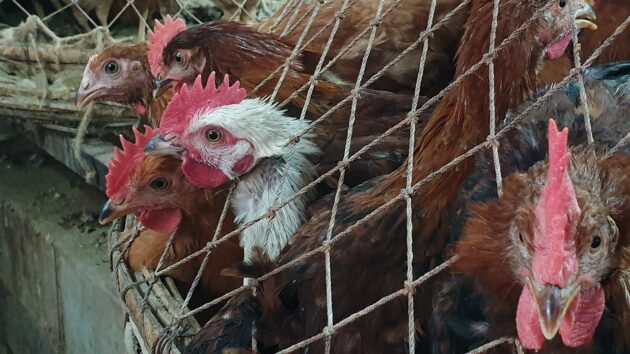
Bird flu control for pandemic prevention must start before poultry reach live bird markets
Published on 01/05/2024

Naomi Marks
One Health Poultry Hub scientists have published research revealing the speed at which avian influenza can spread in Asia’s live bird markets and the urgent need to pivot pandemic prevention strategies.
The paper, published in Nature Communications and entitled ‘Modelling the transmission dynamics of H9N2 avian influenza viruses in a live bird market’, describes how a computer model of avian influenza virus transmission was for the first time input with biological data obtained from chickens in live bird markets. Previous attempts to model avian influenza spread have only ever been theoretical.
The findings show that:
- More than nine in 10 chickens that enter live bird markets without having been previously exposed to the H9N2 subtype of avian influenza virus become infected with it should they remain there for one day.
- The time between a bird being infected with H9N2 and it becoming contagious can be less than five and a half hours in a live bird market.
- One in 10 birds arrive at live bird markets already exposed to H9N2.
The H9N2 sub-type of avian influenza virus is zoonotic, i.e., it can spread to people. It is defined as low pathogenic and causes mild disease but can lead to substantial production losses for chicken farmers. Further, the H9N2 virus has been involved as a gene donor in the emergence of new influenza virus variants. Hence it is considered a potential pandemic threat. Earlier this month, Vietnam reported its first human infection with H9N2.
The findings confirm previous research that live bird markets, which are both ubiquitous and popular in Asia, are hotspots for avian influenza transmission. However, the model enabled the scientists to go one step further than previous studies and evaluate the impact of potential control measures to reduce H9N2 in markets.

Currently, veterinary public health interventions to halt the virus’s spread focus on tackling the disease in the markets themselves. Measures have included banning the storage of birds overnight in markets, enforcing market ‘rest days’ and separating bird species in markets.
Lead author of the research Dr Francesco Pinotti said:
Our research suggests that measures focused on live bird markets only are unlikely to effectively reduce the exposure of market traders and shoppers to avian influenza risk if not complemented with interventions along the networks that supply these markets with birds.
Pandemic prevention strategies therefore also need to target chicken farmers and chicken transporters in countries where the virus is endemic to reduce the numbers of infected chickens being introduced into markets. In particular, our finding make the case for considering multipronged interventions, including vaccination strategies for poultry destined for sale in live bird markets.
The advice comes as other new findings from the GCRF One Health Poultry Hub reveal two to three in 10 chickens in live bird markets in Bangladesh and Vietnam test positive for the risky H9N2 virus.
The insights generated from this research will now further inform the agent-based modelling system EPINEST, the first computer tool for tracking viruses and bacteria as they travel through livestock ‘from farm to fork’, also developed by a One Health Poultry Hub team.


